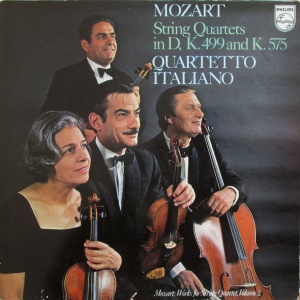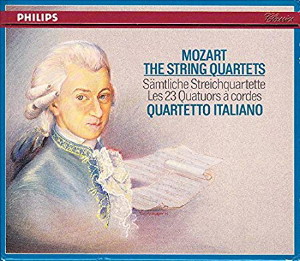 |
|
Philips
- 1 LP - 6500 241 - (p) 1971
|
 |
| Philips
- 8 CDs - 416 419-2 - (c) 1990 |
|
| Wolfgang Amadeus
Mozart (1756-1791) |
|
|
|
|
|
|
|
| String
Quartet No. 20 in D major, KV 499 |
|
29' 15" |
|
| -
Allegretto |
10' 05" |
|
|
| -
Menuetto (Allegretto) |
2' 59" |
|
|
| -
Adagio |
9' 06" |
|
|
-
Allegro
|
7' 05" |
|
|
|
|
|
|
| String
Quartet No. 21 in D major, KV 575 |
|
24' 38" |
|
-
Allegretto
|
7' 25" |
|
|
| -
Andante |
4' 50" |
|
|
| -
Menuetto (Allegro) |
6' 07" |
|
|
| -
Allegretto |
6' 16" |
|
|
|
|
|
|
QUARTETTO ITALIANO
- Paolo Borciani, Elisa Pegreffi, violino
- Piero Farulli,
viola
- Franco Rossi, violoncello
|
|
|
|
|
|
Luogo e data
di registrazione |
|
La-Tour-de-Peilz
(Svizzera)
- 20-30
luglio 1971 |
|
|
Registrazione: live
/ studio |
|
studio |
|
|
Producer / Engineer |
|
Vittorio
Negri
|
|
|
Prima Edizione LP |
|
Philips | 6500
241
| 1
LP | (p) 1971
|
|
|
Prima Edizione CD |
|
Philips | 416 419-2
| 8
CDs - (7°,
1-4, 5-8) | (c) 1990 | ADD
|
|
|
Note |
|
-
|
|
|
|
|
STRING
QUARTET, K. 499
With the six quartets
dedicated to Haydn
between 1782 and 1785,
Mozart openend a new era
in his sring-quartet
writing after a pause of
nine years. One and a
half years later the
String Quartet in D, K.
499 followed. Its
completion can be dated
exactli - from the list
"Verzeichnüss
aller meiner Werke" that
Mozart had been keeping
since 1784 - as August
19 in 1786, the year of
"Figaro." The work is, however,
closer to the Haydn
quartets in character.
Although a buffa
sound may echo in the
simply written unison
theme of the first
movement and in the
stammering start of
a finale full of
humour, the whole
work is like its
predecessors, the
"fruit of long and
hard work." Mozart's
"dedicated bias to
the difficult and
unusual" (a
reproach made by
Cramer's Magazine)
sprang on one hand
from his analysis
of Haydn's
"Russian" Quartets
(1781), which were
written in "a new
and special way,"
and on the other
from his
studies of the
works of Handel
and J. S. and C.
P. E. Bach which
he had come to
know better after
1781 at the home
of Baron van
Swieten. As a
result he had
completely
mastered
thematic-morif
composition and
free-contrapuntal
writing, for which
the "new" type of
string quartet
offered ideal
possibilities.
Mozart used these
methods frequently
in the K. 499
quartet. Thus in
the first movement
the motifs from
the main theme
appears again and
again in many
rearrangements in
all four voices
and in the
trio of the
minuet the
voices are
interwoven
contrapuntally
like fine
lacework.
This
quartet was
published in
1788 by
Hoffmeister in
Vienna, not in
a set but
alone -
something
unusual at the
time. Anton
Franz
Hoffmeister,
who later
founded a
wellknown
publishing-house
in Leipzig but
who at that
time still ran
an art and
music business
in Vienna, had
made a
contract with
Mozart to
publish a
series of his
chamber works.
But when the
first of the
series
appeared, the
Piano Quartet,
K. 478, he
complained
that the piece
was too
difficult and
would sell
badly. Mozart
released him
from the
contract but
by all
appearances
must have had
to repay the
advance
payment with
his quartet.
STRING
QUARTET, K.
575
Mozart's
financial
misery
worsened after
1788 due to
his wife's
illness. In
April 1789 he
eagerly
accepted the
offer of
Prince Carl
Lichnowsky to
accompany him
on a journey
to Dresden,
Leipzig,
Berlin, and
Prague from
which he hoped
his finances
would improve.
His expectations
were not
fulfilled and
he wrote to
Constanze: "My
dearest wife,
on my return
you must take
more joy from
seeing me than
from seeing
the money." He
continued,
however, to
receive
commissions
from Frederick
William II of
Prussia: six
easy piano
sonatas for
Princess
Friederike and
six quartets
for the king.
Mozart applied
himself to the
work
immediately on
his return and
completed the
first quartet,
the D major,
K. 575, in
June, 1789; in
his list
"Verzeichnüss"
he noted it
"for His
Majesty the
Kinf of Prussia."
Of the six
quartets
planned only
two more
appeared he
died (K. 589
and K. 590).
On June 12,
1790 he wrote
to his Masonic
brother
Michael
Puchberg: "In
my present
circumstances
I am forced
to give away
my quartets -
this fatiguing
work - for a
ridiculously
low sum just
to have money
in my hands."
The three
Prussian
Quartets were
published at
the end od
December 1791,
shortly after
Mozart's
death, by
Arteria and
Co. of Vienna.
The
String
Quartet, K.
575 shows no
trace of the
misery
of Mozart's
life and the
foreground is
filles with
unclouded
melodies. With
due
consideration
to the
commissioner,
who was an
outstanding
cellist, the
cello appears
repeatedly in
a dominating
position,
carrying the
melody.
Research has
shown that the
themes of the
first two
movements stem
from the early
1770's. Thus
the theme of
the Andante
which seems to
echo "The
Violet" has,
in fact, no
direct
connection
with that
famous song,
composed in 1785.
It is
significant
that two
themes from
earlier
movements are
united in the
finale to form
a new subject;
this results
not only in
the richly
thematic
nature of the
finale but
also in the
organic unity
of the work as
a whole.
Shin
Augustinus Kojima
QUARTETTO ITALIANO
The "Quartetto Italiano"
is deservedly one of the
most renowned quartets of
our time. It was as long
ago as 1945, soon after
completing their studies,
that Paolo Borciani, Elisa
Pegreffi, Piero Farulli,
and Franco Rossi,
resisting the tempting
promise of individual
careers as soloists,
decided to pool their
youthful enthusiasm and
musical talent and devote
themselves to the
difficult but satisfying
art of playing chamber
music really well. By 1947
the group had established
a firm reputation in
the musical press and
begun giving concerts
outside Italy. In 1951
they visited the United
States for the first time,
and it was soon apparent
that their devotion to
their music and the
impeccable standards of
performances they had set
for themselves were
earning them fame as well
as satisfaction. Over the
years since 1945 they have
remained together, a rare
example of teamwork in
music and something unique
as far as quartets are
concerned. Teamwork in
performance, too has
contributed greatly to
their success. Their
principle of thoroughly
memorising their music and
playing wherever possible
without scores has enabled
them to perform with
astonishing unanimity and
a precision which is
unequalled in their field.
To list the group’s
wide-ranging activities in
more than 25 years is
pointless: they have done
everything one might
expect of one of the
world’s finest quartets.
They have given hundreds
of concerts all over
Europe and in the United
States; they are regular
partecipants in the
chamber-music concours of
many countries; and they
have played and are in
constant demand at the
world’s great music
festivals. Outside the
concert circuit the
members of the quartet
teach chamber music at
both the Royal Academy of
Music in Stockholm and the
Conservatoire in Vienna.
In addition to the many
words of praise bestowed
on them – after their
first concert in New York,
Virgil Thomson, the
distinguished critic of
the “New York Herald
Tribune,” called them “the
finest quartet,
unquestionably, that our
century has known” – they
have been publicly
honoured by the President
of Italy as a more
tangible recognition of
their outstanding artistic
services over the years
to Italy in
particular and the world
of music in general.
|
|
|